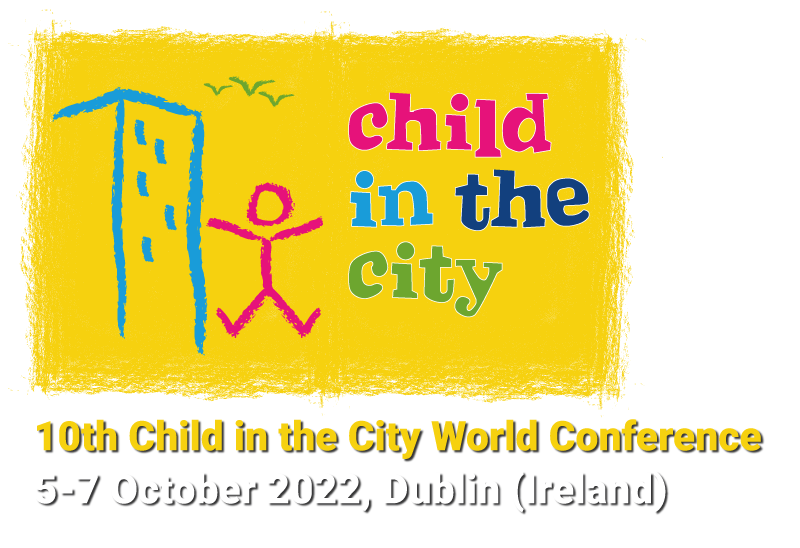Parallel session 2.1: Connecting children’s participation to urban policies
Wednesday, 5th October 14.00 – 15.30, Poddle Room in Printworks Conference Centre at Dublin Castle
 10 years ‘Kinderfreundliche Kommunen’ – Child and youth participation in Germany’s ‘child-friendly municipalities’
10 years ‘Kinderfreundliche Kommunen’ – Child and youth participation in Germany’s ‘child-friendly municipalities’
Anne Müller, Kinderfreundliche Kommunen e.V., Germany
For ten years, the programme and initiative ‘Kinderfreundliche Kommunen’ has been working with cities and communities all over Germany to promote the implementation of the UN Convention on the Rights of the Child (UNCRC) at the municipal level. Reason enough to take a look at the past and present to analyse changes regarding child-friendliness in the participating cities and communities. We, therefore, commissioned an impact analysis, the results of which we will present at the Child in the City World Conference.
‘Kinderfreundliche Kommunen’ is part of the international ‘Child Friendly Cities Initiative’. Cities and communities wishing to participate in the programme develop a unique action plan based on recommendations by ‘Kinderfreundliche Kommunen’. By committing to its implementation, participating municipalities are rewarded with the official ‘child-friendly’ status. The impact analysis compares data from the time the cities and communities entered the programme with the status quo. It aims to identify changes regarding child-friendliness during the implementation period of the action plans.
‘Kinderfreundliche Kommunen’ regards child and youth participation as a core element of child-friendliness. The impact analysis shows a positive correlation between programme participation and improved opportunities for children and adolescents to make their voices heard. For example, among the cities and communities that joined the programme, the number of children’s and/or youth councils has doubled. In addition, all but one municipality appointed a permanent contact for child and youth participation, and one third introduced official concepts for child and youth participation at the local level. The presentation will highlight these and other positive developments.
 Including Youth in the Public Realm
Including Youth in the Public Realm
Patsy Eubanks Owens, Professor, Department of Human Ecology, University of California, Davis
Janet Loebach, Assistant Professor, Department of Design + Environmental Analysis, Cornell University
Helen Woolley, Department of Landscape Architecture, University of Sheffield
The ability of youth to enjoy public spaces and to develop a sense of belonging and attachment to these environments is critical for their physical, social, cognitive, and emotional development. Young people are a vital citizen group with legitimate rights to occupy and shape their public environments. However, youth are often prevented from using public spaces as a result of geographic isolation, discriminating actions, restrictive community policies or ordinances, or negative perceptions of youth. This presentation shares research presented in the forthcoming Routledge Handbook of Designing Public Spaces for Young People. We will present research focused on the need and benefits of considering and consulting youth in decisions related to the public realm. For example, we will discuss the role that the built environment plays in youth development. We also discuss strategies and examples of methods for engaging youth in design and decision-making processes. In particular, we highlight youth-directed or youth-engaged processes as well as methods which respect the rights of youth and privileges their voices. Lastly, we highlight projects that have successfully integrated youth concerns and engagement to realise more youth-inclusive public places.
 Play-friendly cities
Play-friendly cities
Gerben Helleman, urban geographer, researcher in the field of public space and child-friendly cities at The Hague University of Applied Sciences, Netherlands
Fortunately, more and more municipalities are working on play-friendly public spaces. However, many policy visions and investments are still based on assumptions made by municipal officials or suppliers of play equipment. This is partly because good evaluations and effect measurements of existing and new play spaces are scarce, especially where informal play spaces are concerned. And when children are involved in research, they are often asked about their theoretical wishes rather than their concrete actions. To really gain insight into children’s outdoor play, it is important to look at their actual behaviour: who’s playing outside? Where do they play? With whom? And what do they do when they are outside? In this presentation we will show the first results of an ongoing study in the Netherlands that is completely devoted to the child’s perspective.
 A review of the literature supporting children’s opportunities for play within urban housing policies in Ireland
A review of the literature supporting children’s opportunities for play within urban housing policies in Ireland
Fiona Armstrong, TU Dublin
The housing crisis in Ireland is well documented over the last ten years with government funding allocations exceeding 5.5 billion for 2022 (Dept of Housing. 2021). Current housing policy in Ireland is focused on providing additional affordable housing for more people with little detail regarding community facilities or consideration of a child’s right to play. The importance of play and recreation in the life of every child has been acknowledged by the international community and protected in the United Nations Convention on the Rights of the Child (1989). The UNCRC (1989) ratified by 196 countries is the first legally binding international instrument to recognise and protect human rights for children. Play is the main occupation of childhood providing opportunities to develop physical, mental, emotional, and social health (Sutton-Smith, 1997). Children’s rights have become implicit within international government services of health, education, and wellbeing (Hayes, 2002). Bantula and Paya (2020) note that to ensure the rights of the child are meaningful, a state must also promote measures and build strategies that ensure these rights are recognised. As such we must question if the provision of playgrounds and green areas within housing developments when meeting Irish planning requirements for housing, is sufficient to meet the play needs of future child residents. This presentation seeks to examine if Irish urban housing policies inform local planning authorities in protecting a child’s right to play, thereby supporting the state in recognising and protecting human rights for children.
